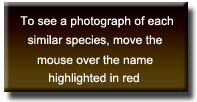
 |
|
|
Leucania commoides does not have a distinct postmedial line of strong black dots and does have a black, slanting line arising from near the base of the lower (inner) margin.
Leucania insueta is a closely related species. The forewing of eastern populations of insueta is brown, not gray-brown. The forewing veins in eastern insueta are heavily accented with light brown. The base of the hindwing of insueta is distinctly lighter than the outer third of the wing, particularly in males. Leucania comma (Linnaeus) Diagnosis: The forewing is gray-brown with a rounded appearance. A dull white streak runs from the base of the wing to the discal dot and accented below with black for about one-half of its length. The postmedial line is represented by a series of distinct black dots. There is no black, slanting line arising from near the base of the lower (inner) margin. The hindwing is strongly suffused with gray-brown. Distribution: This species, apparently introduced from Europe, is represented in the National Museum of Natural by specimens from Newfoundland. Identification Quality: Excellent. However refer to the notes under Leucania insueta for questions concerning the relationship between comma and insueta and its "populations". Habitat: General in Europe and Asia. Newfoundland is in the northern boreal forest biome. Foodplants: Deschampsia flexuosa and Festuca sp. (Hosts Databases, 2005, Gaden Robinson, Natural History Museum, London). Larval Description: None available.
|
Leucania comma
Similar Species: Leucania commoides Leucania insueta
|
Similar Species |
 |
